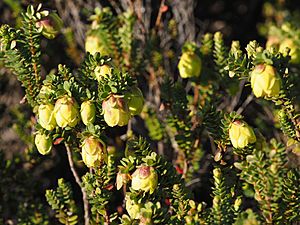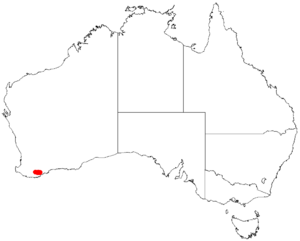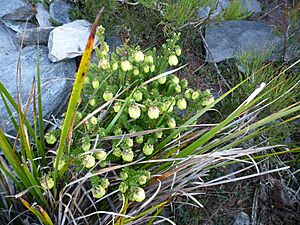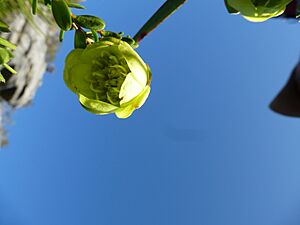Yellow mountain bell facts for kids
Quick facts for kids Yellow mountain bell |
|
|---|---|
 |
|
| Darwinia collina foliage and inflorescences, Bluff Knoll | |
| Conservation status | |
| Scientific classification | |
| Genus: |
Darwinia
|
| Species: |
collina
|
 |
|
| Occurrence data from AVH | |
The yellow mountain bell (scientific name: Darwinia collina) is a special plant from the myrtle family, called Myrtaceae. It grows as a straight, upright bush. This plant has many oval-shaped leaves and bright yellow flowers.
You can only find the yellow mountain bell in a few small spots. These places are all inside the Stirling Range National Park in Western Australia. Because it's so rare, it's listed as an endangered species. This means it's at risk of disappearing forever.
Contents
What the Yellow Mountain Bell Looks Like
The yellow mountain bell is a small, neat bush. It can grow up to about 1.2 metres (4 ft) (4 feet) tall. Its leaves are tiny, only about 10 millimetres (0.4 in) (less than half an inch) long. They are also about 5 millimetres (0.2 in) (0.2 inches) wide and have tiny teeth along their edges.
This plant has unique, bell-shaped flowers. These flowers appear in clusters, usually from March to April and again from August to November. The actual flowers are small and white. They are surrounded by larger, colorful parts called bracts. These bracts look like petals and are bright yellow to lime-green.
The flowers produce a lot of nectar, which is a sweet liquid. This nectar attracts insects. The long, thin parts of the flower, called styles, can be up to 20 millimetres (0.8 in) (0.8 inches) long. Sometimes, they stick out a little past the colorful bracts.
Both the leaves and the bracts of the yellow mountain bell are more rounded than those of other Darwinia plants. The bell shape of the flower cluster helps protect the delicate flowers from rain.
How the Yellow Mountain Bell Got Its Name
The yellow mountain bell was first officially described in 1923. A scientist named C.A.Gardner gave it its scientific name, Darwinia collina. He studied a plant sample collected by "Mrs Pelloe" on Bluff Knoll.
The second part of its name, collina, comes from a Latin word. It means "on a hill," which makes sense because this plant grows on mountain tops. Sometimes, the yellow mountain bell can even mix with another plant called Darwinia leiostyla to create a new type of plant.
Where the Yellow Mountain Bell Lives
The yellow mountain bell is very rare. It only grows in a few specific places. These spots are all within the Stirling Range National Park. You can find it on Bluff Knoll, Coyanarup Peak, Bakers Knob, and East Bluff. These areas are all high up in the mountains.
This plant likes to grow in thick, dense bushes called heath and thicket. It prefers shallow, sandy soils that are on top of sandstone and shale rocks. The places where it lives are usually between 750 and 1090 meters (about 2,460 to 3,576 feet) above sea level.
Sadly, some groups of these plants that used to exist have disappeared since the 1990s. Many of these lost groups, and most of the ones still alive, have been affected by a plant disease. This disease is caused by a tiny organism called Phytophthera cinnamomi.
Protecting the Yellow Mountain Bell
The yellow mountain bell is considered a "Threatened Flora" by the Western Australian Government. It's also listed as "Endangered" (EN) under a big Australian law called the Environment Protection and Biodiversity Conservation Act 1999. This means it needs special protection to survive.
The biggest dangers to this plant are:
- Dieback disease: This is caused by Phytophthora cinnamomi, which makes plants rot and die.
- Fires: Fires that happen too often or not often enough can harm the plant's growth.
- Grazing animals: Rabbits (Oryctolagus cuniculus) and native quokkas (Setonix brachyurus) sometimes eat the plants.
- Human activities: People walking or climbing in its habitat can accidentally damage the plants.
Scientists and park rangers are working hard to protect the yellow mountain bell. They try to control the dieback disease and manage fires. They also educate visitors to help keep the plant safe.
Growing the Yellow Mountain Bell
It's quite tricky to grow the yellow mountain bell. It's hard to get it to grow from seeds. You can have more success by growing it from cuttings, which are small pieces of the plant. It can also be grown in a pot, but it's difficult to keep it healthy in a regular garden. Some people have had luck by grafting it onto another type of Darwinia plant called D. citriodora.




